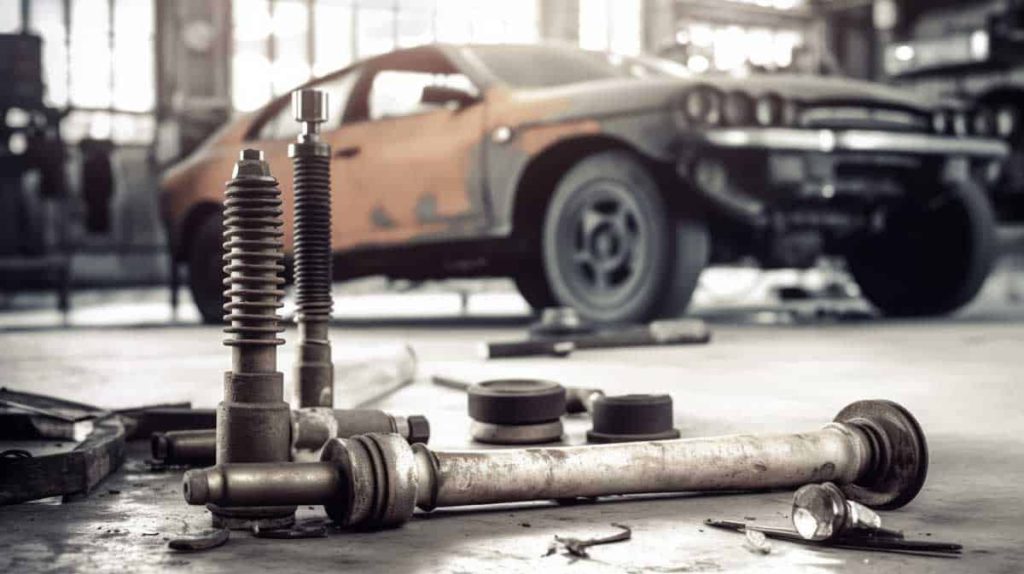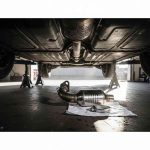As an experienced car owner, I know all too well the importance of having properly functioning car shock absorbers. It’s time for me to take a deep dive and answer the question; what exactly does a shock absorber do? You probably remember from high school science class that shocks are mounted on the vehicle frame to reduce vibration, but there is so much more to it than just one simple part.
After replacing numerous shocks, and dealing with rough ride conditions and unpaved roads, among other situations that have tested my trusty family wagon’s suspension system over the years, I would love to share some insights gathered firsthand – along with a few good anecdotes all in an effort to help others make sure they can enjoy their rides safely. Let’s explore together why it may be wise (and fun!) to change your car shocks as needed.

Introducing the Shock Absorber – What It Is and What It Does
Did you know that your car, much like a trusty steed, is equipped with a special feature to protect not only itself but also its driver? It’s true! The shock absorber acts as the vehicular equivalent of an invisible cushion – it helps take the edge off those potentially jarring rides caused by potholes and speed bumps. An integral part of any suspension system worth its salt, this unsung hero does more than smooth out your ride; it could mean all the difference between discomfort or worse for both you…and poor little Fido in his crate! So next time life throws some roadblocks (literally!) at ya’, remember: someone is looking over us from under our hoods.
The Basics Behind the Shock Absorber and How it Works
There’s nothing like the adrenaline-fueled thrill of a fast drive, but without reliable shock absorbers, that energy can quickly turn into an unfortunate disaster! After all, it’s those powerhouse pistons and hydraulic fluid working together to protect your suspension from bumps in the road. Trust me – you do NOT want to experience what happens when these vital components fail! Investing in quality shocks is essential if you’re looking for safe rides with plenty of speed each time out behind the wheel.

Three Types of Shock Absorbers – Which is Right for Your Car
Car lovers are faced with a seemingly endless array of options when it comes to shock absorbers. From hydraulic shocks that promote softer rides, gas-filled varieties for superior handling and durability, or spring-based models offering affordability – there is something to fit every driving style and road terrain. The choice might be daunting but each type carries its own unique benefits – so don’t skimp on researching your best option before investing in new shock absorbers! Your car will thank you later.
Benefits of Replacing an Old or Worn-Out Shock Absorber
Tired of feeling like you’re on a bumpy rollercoaster ride every time you hit the smallest pothole? Replace those worn-out shock absorbers, and suddenly your everyday drive can feel more smooth than ever. Not only is this helpful for safety reasons, but it also has an impact on car performance – making handling easier and quicker when cornering or accelerating/decelerating. Don’t wait till it’s too late to replace them: reap all the benefits now!
FAQs
What are the symptoms of bad shock absorbers?
Fluid leakage is one of the most common signs that your shock absorbers may not be functioning correctly. If you’re seeing fluid running down the side, or even just seeping from their bodies, it’s important to get a professional opinion—your mechanic can inspect for dents and corrosion in order to diagnose any potential problems before they worsen. Don’t wait too long; an ounce of prevention really does go a long way when it comes to protecting your shocks!
Tire Wear, If your vehicle’s tires have seen better days, there may be an underlying issue. Uneven or flat tire wear can signal the need for a check-up; such issues are often caused by worn shocks that cannot keep the rubber firmly on the pavement.
Excessive Bouncing, If your car is still shaking and quivering long after you’ve driven over a bump in the road, it’s likely time for new shocks or struts. Don’t let rough roads ruin your ride – get those suspension parts replaced!
Front “Nose-Diving,” If you notice your car has difficulty coming to a stop or it feels like the front is “nosediving” when braking, chances are that something’s wrong with your shocks and struts. The shock may be struggling to absorb all of the piston rod lengths, which can extend stopping distance and reduce overall performance – this could mean it’s time for an inspection!
Rear “Squatting” If your car feels like it’s dropping suddenly while accelerating or shifting to one side during a turn, you might need new shocks and struts.
Instability At High Speeds, As your car ages and the suspension wears, you may notice that it starts to lack control at higher speeds. Suddenly steering is more difficult as the vehicle begins to drift from side to side or violently bounce over bumps instead of staying smooth on its course. If this is happening with yours, beware: these are telltale signs of a much bigger problem!
Can you drive a car with a broken shock absorber?
NO!, Driving with a broken shock absorber is not recommended – it can cause long-term damage and negatively affect the stability of your vehicle. You could end up doing more harm than good if you attempt to drive with any part of your suspension damaged, like a collapsed coil spring or worn-out shocks. Your safest bet? Don’t take that risk!
How often should shock absorbers be replaced?
Driving on bumpy roads and aggressive driving can take a toll on your car’s shock absorbers. While normal vehicles should replace their shocks every 50,000-100,000 miles, more strenuous usage may decrease the lifespan of these essential parts drastically. Keep an eye out for performance deterioration to proactively replace shocks before reaching maximum mileage!
What is the lifespan of a car shock absorber?
Shock absorbers are your car’s unsung heroes, ensuring a smooth ride over bumpy roads! Generally, their life expectancy is around 4-5 years; however, if you have the luxury of driving on even surfaces like superhighways, then expect up to ten years of service. On the other hand, those without such luck might not get more than five out of it – so be sure to thank them for all that they do by regularly checking and maintaining them when needed!
How much does it cost to fix shock absorbers?
Make sure to have your suspension shocks and struts checked regularly – the average cost of a replacement runs from $800-$900, with labor costs being estimated at around $200-$260 and parts costing between $600-650.
What happens if you drive with bad shocks?
If you’re driving with bad shocks, beware – your car might start to feel out of control. Sudden turns and gusts of wind can cause it to roll or sway unexpectedly, resulting in a loss of handling that could be dangerous for everyone on the roads.
Should I replace my shock absorber or my whole shocks?
Instead of replacing just one shock absorber, it’s best practice to replace them in pairs or all four for optimized driving stability and comfort. This ensures that you have even, predictable control over your vehicle no matter the terrain!
Is a car shock absorber repairable?
YES, leaky car shock absorbers can be repaired – but it’s not something to get excited about! Even though dampers might seem fixable, they’re often subject to unequal pressure, which affects your vehicle’s performance and handling.
Can I replace my car shock absorbers myself?
With a bit of know-how and the right tools, you can become your own mechanic and learn how to replace shocks or struts with ease. If tackling vehicle repairs is in your wheelhouse, then this job should be no problem for you!
How can you test a car shock absorber?
Want to test your car’s shock absorbers for performance? Try the bounce test: lean on the front guard or a bumper and release suddenly. If it rebounds multiple times before settling, you need new shocks! You can also try this driving slowly; if there are bounces when stopping quickly, time to shop around for replacements. Don’t forget about an inspection of mounting points and any suspicious moisture near the sides – these clues could signal some serious issues with your suspension system.
What is the difference between shocks and suspension?
The suspension of a car is like its foundation, supporting the vehicle’s weight and determining how much motion it will have on different roads. On the other hand, shocks act as a governor to regulate this movement by controlling how quickly or slowly they occur. Together they form an essential partnership in making sure your journey stays smooth!
Should you buy used car shock absorbers?
If you’re looking to save a few bucks, buying used suspension parts at a local junkyard may seem like an enticing option. However, it’s important to understand that these parts are likely worn and won’t last nearly as long as new shocks would. When shopping for pre-owned shock absorbers or dampers, take the time to give them a good once-over in order not end up disappointed!
Test your Car Shock Absorbers.
Check your car’s shock absorbers and suspension system conveniently with the easy-to-use bounce test! Simply lean on a part of the body such as its front guard or bumper, then quickly release – if you notice multiple rebounds before settling back into place, this indicates that it may be time to invest in new shocks. Additionally, driving at low speed can help reveal any signs of bounces when coming to an abrupt stop which could also point towards worn out components. Regularly examine mounting points for issues too; plus watch out for any moisture nearsidesas these are major indicators that something is amiss within the suspension system.




